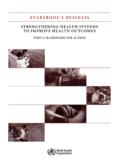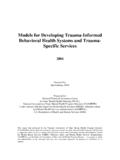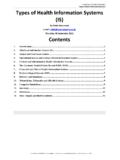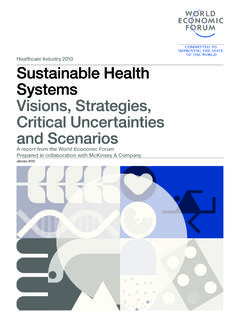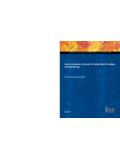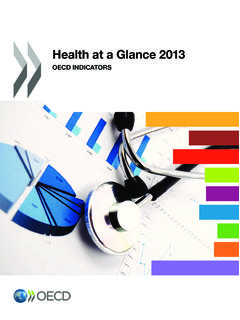Transcription of Tax-Based Financing for Health Systems - WHO
1 World Health Organization Geneva EIP/ PAPER NUMBER 4 - 2004 Department " Health system Financing , Expenditure and Resource Allocation" (FER) Cluster "Evidence and Information for Policy" (EIP) Tax-Based Financing for Health Systems : Options and Experiences World Health Organization 2004 This document is not a formal publication of the World Health Organization (WHO), and all rights are reserved by the Organization.
2 The document may, however, be freely reviewed, abstracted, reproduced or translated, in part or in whole, but not for sale or for use in conjunction with commercial purposes. The views expressed in documents by named authors are solely the responsibility of those authors. Tax-Based Financing for Health Systems : Options and Experiences by William Savedoff WORLD Health ORGANIZATION GENEVA 2004 Tax-Based Financing for Health Systems : Options and Experiences I.
3 Introduction Out-of-pocket spending is the most frequent way to pay for Health services around the world. However, as a share of the total value of global Health spending, it is eclipsed by social insurance, private insurance and general taxation. These latter forms of payment provide better financial protection for households because they are "prepaid" and pool Health risks across individuals. Of these prepaid Financing mechanisms, general government revenues are the most widespread, providing substantial funding for Health services in almost every country.
4 In fact, government revenues are the predominant source for Health care expenditures in 106 out of 191 WHO member Paying for Health services out of government tax revenues is a fairly recent innovation in Health care Financing . Until the mid-twentieth century, the major alternatives to out-of-pocket payments for Health care services were private philanthropies, mutual associations or social insurance plans ( sickness funds). Local governments generally contributed funds to maintain or invest in hospital and indigent care, but this did not represent a coherent national strategy for Health care funding until well into the 20th century.
5 By contrast, Germany's policy to combine its sickness funds into a social Health insurance system -- generally credited as the first effort to enact universal Health insurance coverage -- dates from the second half of the 19th century. Health Financing Systems in which government revenues are the predominant source for Health care expenditures (hereafter referred to as " Tax-Based Systems ") began in two different ways. In the first set of countries, the Tax-Based system was built on a foundation provided by the earlier development of social or private Health insurance.
6 For example, Britain passed its National Insurance Act in 1911, financed through payroll contributions, and didn't adopt a universal tax-supported Health system until after World War II. This pattern is common among Western European countries. In the second set of countries, the Tax-Based system evolved from Health services administered directly by colonial regimes. This pattern is found mainly among developing countries that were colonized or heavily influenced by Britain -- such as Malaysia, Singapore, Hong Kong, and many countries in Africa and the Caribbean.
7 Regardless of the starting point, Tax-Based Systems share common advantages and disadvantages. Since payment is mandatory, the system avoids many problems that are common to voluntary insurance markets. Tax-Based Systems can benefit from scale economies in administration, risk management, and purchasing power. These strengths come from the collective and political nature of raising and allocating tax revenues in a modern nation-state. Nevertheless, the weaknesses of such Systems emerge from this same political-economic feature.
8 Namely, inefficiencies that emerge from serving multiple objectives, political pressures to serve privileged groups, the normal challenges 1 For the purposes of this paper, countries are defined as having predominant funding from government revenues if these revenues account for more than half of government Health spending and government Health spending represents more than half of all Health spending. 2 of effective management in public services, and problems associated with weak accountability and instability (Inter-American Development Bank 1996); (World Bank 2004); (N.)
9 Birdsall, R. Hecht 1997). This paper discusses the use of tax revenues as the predominant source of Health care Financing . It defines " Tax-Based Systems " as those in which more than half of public expenditure is financed through revenues other than earmarked payroll taxes ( to distinguish it from social security or social Health insurance), and in which access to publicly-financed services is, at least formally, open to all citizens. Consequently, this paper complements a series of studies produced by WHO on other forms of Health care Financing , including social insurance (G.
10 Carrin, C. James 2003), private Health insurance (N. Sekhri, W. D. Savedoff 2003), community Health insurance (G. Carrin 2002) and user fees (A. Singh 2003). The following section presents an overview of the main forms of taxation that fall within this rubric, along with advantages and disadvantages. It then discusses the main issues involved in management and use of tax revenues for Health care services. It proceeds to illustrate these issues through the experience of several countries with general Tax-Based Health Systems .











